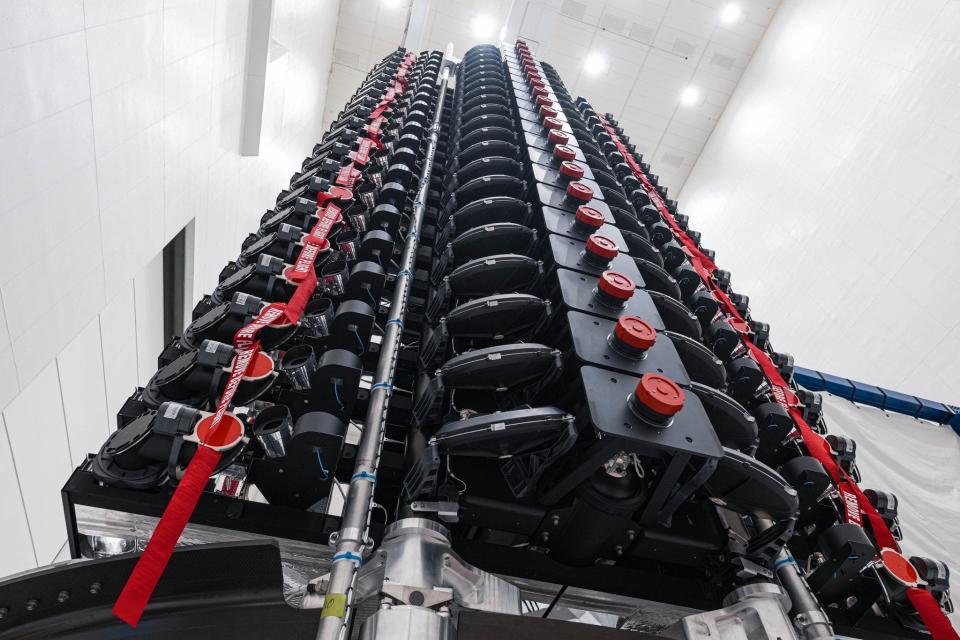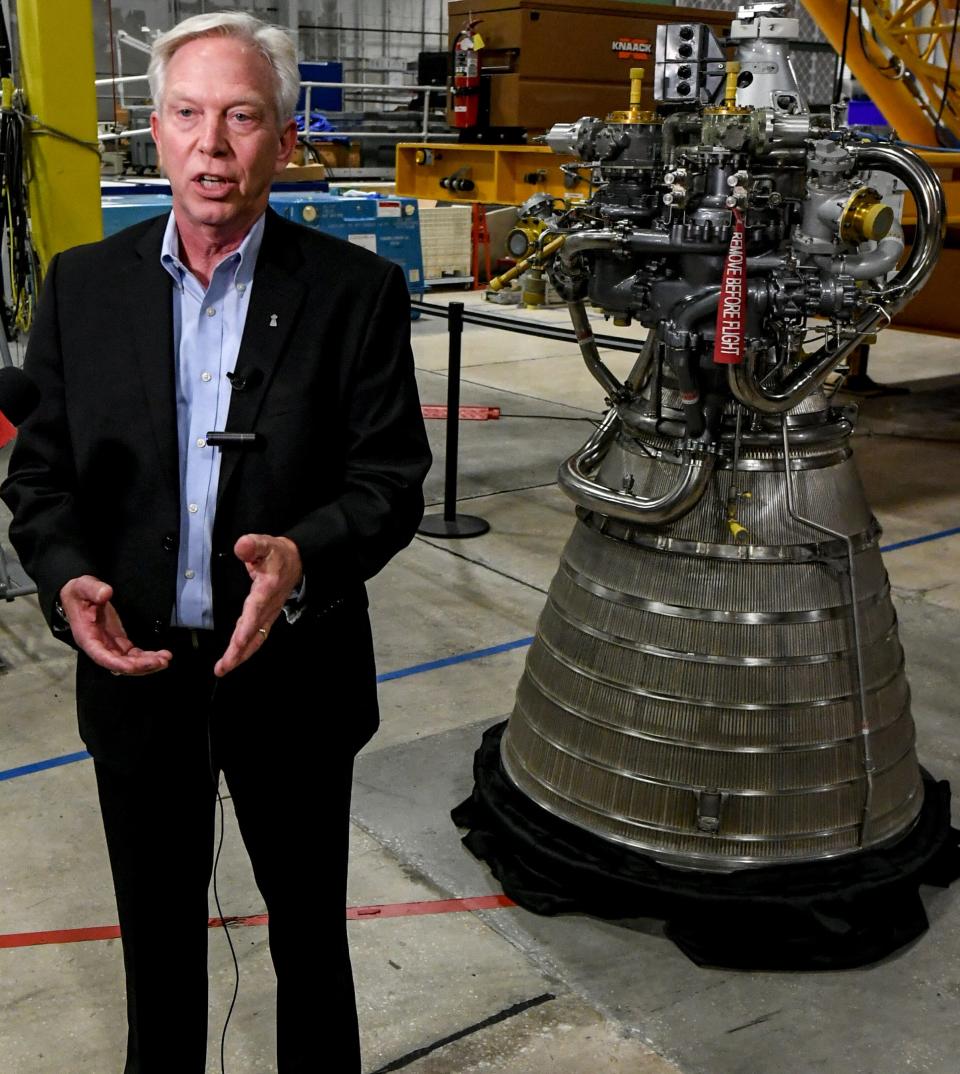Race for bandwidth: Internet satellites fuel record-breaking launch year on Space Coast
The high-tech race for SpaceX, Amazon and competitors to create mega-constellations of internet-beaming satellites is spurring record-shattering rocket launch activity on the Space Coast.
Why? Worldwide broadband data delivery will become a new, invisible 21st century "backbone of our society" — much like underground sewer pipes and undersea telegraph cables during the 19th century, said Jonathan McDowell, an astrophysicist at the Harvard–Smithsonian Center for Astrophysics.
In unprecedented fashion, Cape Canaveral Space Force Station and NASA's adjacent Kennedy Space Center racked up 72 orbital launches during 2023. That represents a robust 26% increase over the previous annual record of 57 launches, set just last year.
Only three missions were crewed by humans — while SpaceX launched 43 Starlink internet-satellite missions.
“You won’t have lost any bets in my lifetime by going, ‘We need more bandwidth.’ Every time, someone’s gone, ‘Why would you need that much bandwidth? You’ve already got a 1200-baud modem. Isn’t that enough?’ " McDowell said.
"There’s always ways to fill the bandwidth, right? So it’s that insatiable demand for increasing amounts of data, speed of response, speed of upload and download times of all kinds. And everything we do in life is sort of being is abstracted into data now,” he said.
By McDowell's latest tally, SpaceX has launched 5,650 Starlink satellites since February 2018. That sum includes launches from Vandenberg Space Force Base in California. Of that total, 5,233 Starlink satellites remain functioning in orbit. Starlink serves more than 2.3 million people in more than 70 countries, SpaceX reports.
But another major player has emerged. Amazon’s $120 million Project Kuiper broadband-satellite processing facility is scheduled for completion in 2025 at KSC's Launch and Landing Facility. After its successful launch of two prototype satellites in October, Amazon is now manufacturing satellites and aiming for full-scale deployment starting in the first half of 2024, Space Florida reported.
The goal: Create a constellation of 3,236 satellites in low-Earth orbit.
Looking ahead, NASA predicts a even-faster cadence of nearly 100 launches next year from Brevard County.
"Another jam-packed year is in store for NASA’s Kennedy Space Center in Florida as the momentum of a busy 2023 is carried forward into the new year," a NASA press release said.
"On the horizon are missions to the Moon, more crew and cargo flights to the International Space Station, and several upgrade projects across the spaceport," the press release said.
SpaceX is 'driving the show'

Don Platt designed and coded embedded systems used on space shuttles as lead software engineer with Bionetics Corp. at Kennedy Space Center. He is now director of the Florida Institute of Technology's Spaceport Graduate Center in Titusville, and he laughed while describing his thoughts on launches nowadays.
“From a personal perspective, I used to be all excited and go outside and make sure I had my binoculars and observe the launch,” Platt recalled.
“And now I'm sitting here on my computer, and the building starts to rumble: ‘Oh, well, there's another launch,' " he said.
Regarding this year's record-breaking launch tally, Platt said, “it really is SpaceX driving the show." Indeed, SpaceX rockets accounted for all but four of the Space Coast's 72 liftoffs this year. The exceptions:
United Launch Alliance launched rockets on June 22 (Delta IV Heavy), Sept. 10 (Atlas V) and Oct. 6 (Atlas V).
Relativity Space launched the world's first 3D-printed rocket during a March 22 demonstration mission.
Capping the landmark year, SpaceX crews launched a Falcon Heavy triple-core rocket followed by a Falcon 9 rocket within 2 hours and 54 minutes Thursday night from Cape Canaveral.
"2023 has been a year of unprecedented growth in the aerospace industry in Florida, and that includes a record-breaking number of launches from Cape Canaveral. By the end of the year, approximately 70% percent of total U.S. launches will have happened in Florida," Space Florida President and CEO Rob Long said in an email.
"Not only does this pace demonstrate Florida’s position as the world leader and the premier location for global aerospace commerce, it also captures the overall health of the industry. Yet even as we reflect on what our partners across the industry have accomplished this year, 2024 looks even brighter," Long said.
Ramping up launch-related infrastructure

A new rocket is entering the mix next year. United Launch Alliance will debut its next-generation Vulcan rocket — replacing the aging Atlas V and soon-to-be-retired Delta IV Heavy — during a Jan. 8 maiden flight from Cape Canaveral Space Force Station.
Because of high customer demand, ULA has already accumulated a waiting list of more than 70 future Vulcan launches. Aerojet Rocketdyne is hustling to build engines for all those rockets.
"We're north of a 150-engine backlog right now," Jim Maus, Aerojet Rocketdyne vice president of program execution and integration, said during a November media event at ULA's Advanced Spaceflight Operations Center at Cape Canaveral Space Force Station.
Maus said these RL10 engines are built in West Palm Beach. Annual production will ramp up from 16 to 18 engines up toward 40, with new additive manufacturing techniques replacing tube-welding fabrication.
"We're stepping away from the hand fabrication and becoming more of a machine-built chamber. When it comes to the test area, we're activating a second test stand to be able to have the capacity to be able to test engines to deliver them to ULA at the rate they demand," Maus told reporters.
Former NASA Administrator Jim Bridenstine credits NASA and the Space Force for boosting launch cadence by transforming access to space. Rather than purchasing, owning and operating hardware, he said both agencies now look to buy services from commercial companies, spurring private investment.
Bridenstine said this new governmental approach "really opens the aperture to a whole host of new capabilities, and a whole brand-new market that is extraordinarily large."
"All of a sudden, it's not a zero-sum game. We don't know what the limit is. Here's what we do know — we're not anywhere close to what the limit is," he said of the Cape's launch capacity.
Rick Neale is a Space Reporter at FLORIDA TODAY (for more of his stories, click here.) Contact Neale at 321-242-3638 or rneale@floridatoday.com. Twitter/X: @RickNeale1
This article originally appeared on Florida Today: SpaceX Starlink constellation fuels historic launch year on Space Coast

